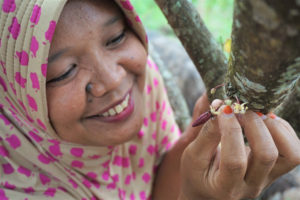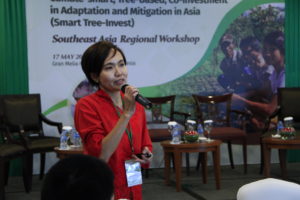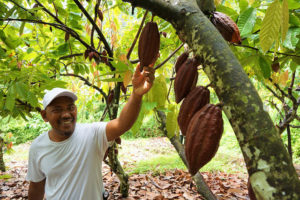
The World Agroforestry Centre (ICRAF) recently marked the end of its Climate-smart, Tree-based Co-investment in Adaptation and Mitigation in Asia (Smart Tree-Invest) project with a closing event in Jakarta.
Smart Tree-Invest, supported by the CGIAR Research Program on Forests, Trees and Agroforestry (FTA) and the International Fund for Agricultural Development (IFAD), worked in watersheds in Buol, Central Sulawesi, Indonesia; Lantapan municipality, Bukidnon province, the Philippines; as well as Ha Thinh and Quang Binh provinces in Vietnam.
The project, which ran from 2014 to 2017, aimed to improve the livelihoods and resilience of smallholder farmers through the promotion of climate-smart, tree-based agriculture in the three countries, aimed at reducing their vulnerability to climate change.
It did so by developing co-investment models that involve smallholders as ecosystem service providers while local governments and the private sector invest as ecosystem service beneficiaries.
Based on diagnostic studies of needs and opportunities in each country, the project introduced novel tree-planting schemes to improve the quality of home gardens, smallholders’ plantations, riparian and sloping land — and ultimately the quality of the environment and local livelihoods.
The process of identifying opportunities as well as new schemes for using resources available locally have been adopted by local governments in the three countries, overcoming their initial skepticism based on past ‘project’ experience. Moreover, toward the end of the project, private sectors were eager to join in initially monitoring ecosystem services in their sites in Indonesia, supporting market access for smallholders in Vietnam, and starting the initial incentive flow in the Philippines.

Smart Tree-Invest was the first project to explicitly pilot the development of Co-investment in Ecosystem Services (CIS) schemes, a concept that emerged from earlier Payment for Ecosystem Services (PES) ideas. More than 600 farmers from the three countries were involved in co-investment activities.
Watch: An introduction to the Smart Tree-Invest project
FTA researcher and ICRAF ecosystem services specialist Beria Leimona, who was the overall leader of Smart Tree-Invest, noted the similarities between the three countries.
“We chose these sites because we work closely with the International Fund for Agricultural Development or IFAD [which had established a presence in the areas through previous projects] and all of the sites are remote, and they are more or less the ‘poorest of the poor’,” she said.
The Lantapan watershed had previously hosted an investment in environmental services project. There was also investor interest in the areas in terms of the private sector, including a major hydropower company in the downstream. It was the first time co-investment had been implemented on the ground.
The area “had been degraded to some extent,” Leimona said. ICRAF has had a presence in Lantapan for quite some time, she explained, beginning with the Landcare initiative in the 1990s.
“With Landcare, we saw the potential: we gave the awareness [about tree planting], but what sort of incentives would make them want to sustain the pilot?”
Following that was the Rewarding Upland Poor for Environmental Services (RUPES) project with its incentive system for farmers.
Researchers subsequently “added information about what type of ecosystem services farmers and outside beneficiaries could get if they planted trees on their farms, which was in this case the watershed functions — increasing water quality for the company and also reducing erosion from farmland.”
“Through Smart Tree-Invest, we wanted to get more stakeholders involved in linking development programs with well-measured conservation objectives to result in green-growth scheme in their jurisdictions, including IFAD as the development agency and particularly the district and provincial government,” Leimona said.
Read also:
- Making farms sustainable and climate-smart with agroforestry: two stories from Smart Tree-Invest
- Building trust to smartly invest in trees in the Philippines: A visit to the Tala-andig tribe
- Smart Tree-Invest spurs local administration to begin farmers’ learning groups

Buol in Indonesia and Ha Tinh in Vietnam were more remote than the Philippines site. There was “almost no private sector,” Leimona said, adding that there was also less interest from business and infrastructure was less supportive.
She put this down to the area not being “sexy” or high-profile like locations such as Kalimantan, leading to almost no projects occurring there.
The silver lining was that “the enthusiasm of the local government was very high because they were quite eager to see what happened.”
Among the other notable differences between the sites were that in terms of the landscape structure, Vietnam did not have a mixed system or agroforestry. That stemmed from land-use policy, said Leimona, whereby farmers must follow government requirements on what to plant on their land.
In Buol, agroforestry existed with crops such as cacao, coconut and candlenut, Leimona explained. However, it had not been commercialized and was not well managed. “People didn’t think it could be a source of future profits,” she said, adding that farmers previously concentrated more on their patchouli or paddy fields.
Among other approaches, the project used the Capacity Strengthening Approach to Vulnerability Assessment (CaSAVA) framework, which ICRAF developed. The participatory approach of CaSAVA helped the collection of local ecological knowledge from smallholders in Lantapan, according to researcher Kharmina Anit in the Philippines, and increased their awareness of the issues in their landscapes, encouraging practical adaptation solutions at the community level.
The project also provided best practices in support of the implementation of policies in each country.
In Buol, the local administration has committed to replicating Smart Tree-Invest activities including farmers’ learning groups and watershed and tree-planting monitoring. The project was implemented in two subdistricts in the Buol watershed, and the district administration is set to expand activities to the Mulat-Lantika Digo watershed, using its own funding.

The administration has requested ICRAF’s support through continued technical assistance as it replicates the project activities after the project’s end.
Watch: Impacts of Smart-Tree Invest project after 3 years
In summing up the project’s impacts and its relation to greater goals at the closing event in Jakarta, FTA scientist Meine van Noordwijk said it was “not only about healthy food but also healthy farmers and healthy forests […] in the frame of climate change.”
Unlike management systems that require results to be outlined beforehand and achieved, Van Noordwijk added, Smart Tree-Invest made a commitment and then awaited the impacts. The “open-ended” learning approach fit into existing structures of regulations and funding mechanisms, as well as working within local contexts.
“[This] provided food for thought on how we may see one object from different perspectives, and end up with different results,” said ICRAF ecosystem services specialist Sacha Amaruzaman. “Professor van Noordwijk reflected on the different characteristics of three country sites; how the similar start in each site through the application of the CaSAVA framework ended up with different co-investment schemes.”
“Clarification of the issues, weighting the trade-off between options and considering context are the three actions required to achieve development goals,” he added.
The partnerships formed with governments and other stakeholders stand as testament to this, as does the continued commitment in the sustainability of the project.
By Hannah Maddison-Harris, FTA Communications and Editorial Coordinator.
This work forms part of the CGIAR Research Program on Forests, Trees and Agroforestry (FTA). We would like to thank all donors who supported this work through their contributions to the CGIAR Fund. This project was supported by the International Fund for Agricultural Development (IFAD).











